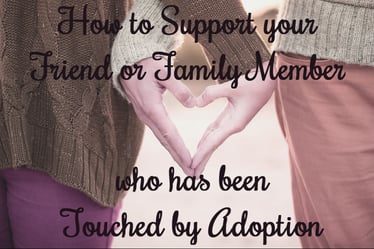As many people as there are in the world who have been touched and forever changed by adoption, there are many more that have not and may not fully understand the adoption journey. Birth mothers, adoptive parents and adoptees many times will find themselves surrounded by people who have never experienced placing a child, adopting a child, or dealing with what it means to be adopted. These people are their friends, family members, neighbors and co-workers. Many times, members of the adoption triad can be left feeling unsupported, hurt or offended by their friends and family members who don’t know how to support them on their journey, say something hurtful without thinking or simply don’t understand their choices or their family.

So, what can a friend, family member, neighbor or co-worker do to support someone they know who has been touched by adoption in any way? The most important way is to listen and be there for them if they need you. Remember that adoption involves both joy and sorrow. Think about the meaning behind your words before you speak. Most importantly, do not judge.
Do not presume that you know their journey. Whether someone you know is an adoptee, a woman who has placed a child for adoption or an adoptive parent, you cannot really know the personal ramifications of the very hard choices they have made. Every adoptee, birth mother and adoptive family has the right to their own story.
Birth mothers are often in need of support from friends and family. Many birth mothers fear being judged for their decisions. If you have not been in their shoes, you cannot know the amount of love and strength it takes to place a child in another family. Remember that she is not “giving up” her child because it is convenient or an easy choice. She is an amazing, strong, loving woman who is making an impossibly hard decision about choosing a different family and life for her child. If you know a birth mother, the most important thing is to be there for her, both before and after the birth. Recognize that her road is rough and just offer to be there for her for whatever she needs. That could be rides to the doctors, someone to come with her to her sonograms, someone to just talk to, someone to have on call in case she has a crisis of any kind, someone to help her pick out maternity clothes, or any other thing she personally might need. You may not understand her reasons, her choices or her journey, but that does not mean you can’t accept it and accept and love her.
Every adoptive family also has their own story. While the vast majority of parenting an adopted child is the same as parenting a biological child, there are some big differences. This is even more true if a family has adopted an older child. Many adopted children have a history of abuse, abandonment, neglect, malnourishment or other sources of trauma. Traumatized children can display a range of behaviors that would be considered negative for a non-traumatized. Children could also have developmental delays, learning disabilities or physical disabilities. Parenting a traumatized or developmentally delayed child can look very, very different than parenting a non-traumatized or normally developing child. As a simple example, sometimes punishments such as taking away privileges don’t work so non-traditional consequences are used. Sometimes, an undernourished child just needs calories and they refuse to eat what is presented to them at dinner but will eat, say, french fries and jelly sandwiches all day so that is what their parents feed them. It is important to not be judgmental of parents when you see a non-traditional parenting approach. Unless you are an expert in parenting adopted and possibly delayed or traumatized children, then do not presume you know what is the best for someone else’s children. Adoptive parents are the experts on their own children, and they know what will work for them and what wont. They have access to the support of other adoptive families, social workers, doctors, counselors, and behavioral experts. They have spent hours upon hours educating themselves about how to parent adopted children. They most likely do not need your advice (unless of course they ask), but they do need your support and understanding. The strongest people still need friends and family to lean on. They might need a babysitter, someone non-judgmental to vent to, someone to invite them out for a drink once a month, someone to help them catch up on house work, or any range of things. The most important thing for you is to be there, be understanding and ask if they need help. All new parents need help, understanding and support, even if they are new parents to an older child!
Transracial families built through adoption are very common, and can look very conspicuous to others. Some people may find it hard to accept that parents of one race are parenting children of different races. Some people may find themselves wanting to ask questions about the children. When adopted families don’t look “related,” it can lead to strangers, friends and family being uncomfortable or too inquisitive. It is important to be sensitive to the children and the family’s privacy. Remember that you don’t have a right to know a child’s or a family’s history unless they would like to share it with you. Try not to single out a child who is a different race than her parents or siblings in uncomfortable ways. For example, a little girl with natural African-American hair that is vastly different than her parents probably already knows how different she looks. While you may intend to make her feel good by saying how beautiful her braids or her kinky hair or her skin tone are, for her it might be a reminder of how different she looks and feels. For this reason, you should make a conscious effort to treat every member of a family built through adoption the same as you would treat any other family.
On the flip side, you should avoid being “colorblind.” Pretending you don’t see race or ethnicity is also damaging. Race and ethnicity are a very important part of anyone’s identity, and by pretending not to see them you could make a child feel that that part of them is being erased. If you have connections to a community of people that share the same heritage of an adopted child, ask the parents if you can involve them and their child in some way. If your neighborhood has a great Ukrainian festival every year and you know someone who has adopted from Ukraine, invite them! If your sister-in-law is Puerto Rican and so is your friend’s adopted child, see if you could get everyone together for a meal or an event! There are many ways you can appreciate and help foster a child’s heritage while treating them just like any other child. Always make sure you run anything past the parents first.
Just as an adoptive family has a right to privacy, every adoptee has the right to share or not to share whatever they choose. Respect how they present the story of their past, present and future. Don’t press them, their parents, siblings or close friends for details of their adoption or personal details of their life. Just because they have a unique story does not mean it needs to be shared. Support them in whatever journey they choose to take. Don’t tell them how “lucky” they are to be adopted... there is no luck involved in being placed for adoption. Is it lucky that they grew up in an orphanage, or were born to parents who could not parent them at that time in their lives, or lived the first years of their life in foster homes? Don’t treat them differently than any other person- after all, they are just another person in your life. Their origin story does not change their status in their community or family. If you would like to gain some insight into the effects of adoption on the adoptee, try reading some of the many adoptee blogs available and consider asking your older adopted friend or family member any respectful questions you may have. They might appreciate it if you ask about their preferred adoption language, but if they don't welcome your questions then don't push it. While it is good to try to gain an understanding from their point of view, if they do not feel comfortable speaking to you about it then it is their right to not answer your questions.
The most important way you can support anyone you know and love who has been touched by adoption is to be supportive, understanding, non-judgmental and positive. Educate yourself about positive adoption language and use it. Remember that even though their journey, their family and their choices may be different than yours, they are people who deserve privacy, respect and compassion just like anyone else. While you may not understand their journey or their choices, you can accept and support them.
If you have any adoption questions, please feel free to ask us by clicking the button below. Any questions and communications are 100% confidential, and our staff is comitted to compassion and sensitivity. We welcome any questions, and will be happy to help!




Let Us Know What You Thought about this Post.
Put your Comment Below.